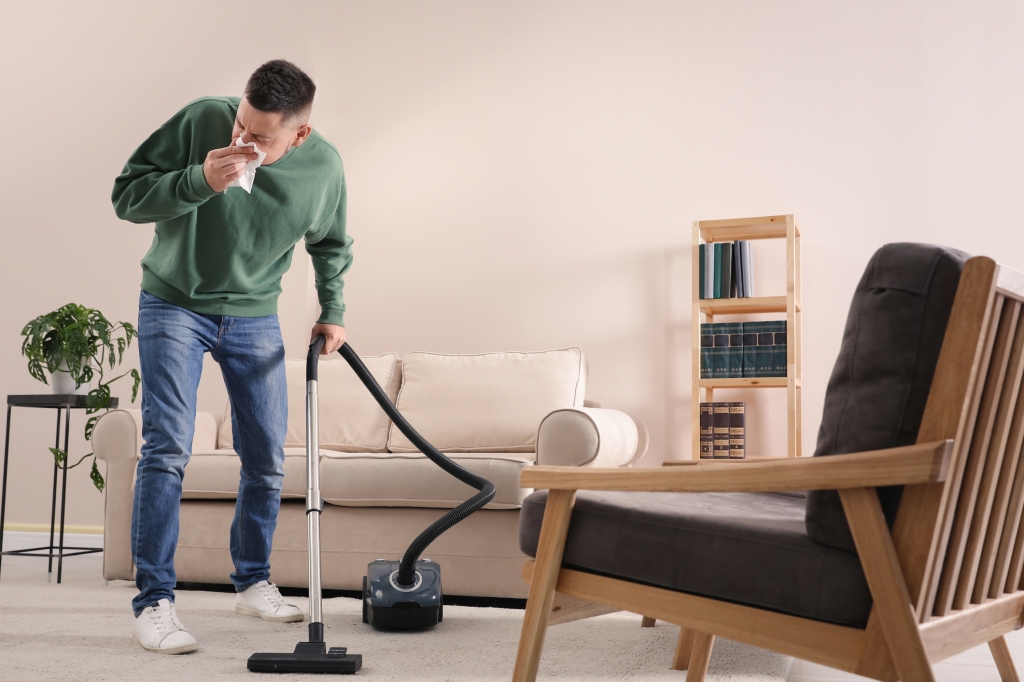
Achoo! Wheeze. Pass the tissues, please.
More than one in four Americans suffer from seasonal allergies, or hay fever, according to the Asthma and Allergy Foundation of America. If you’re one of them, you know firsthand that taking in the great outdoors can make your eyes water, your throat itch, your nose run, and your pockets and waste baskets fill with soggy wads of tissue.
Right now, most parts of the country are in the thick of it. Though pollen seasons vary depending on location, the cycle goes roughly like this: Tree pollen peaks from spring to early summer, when grass pollen kicks up, followed by weed pollen in the fall. So much for those summer picnics.
But you can make your home a haven from allergens by practicing some basic house hygiene, according to the allergy foundation.
“It takes effort,” says biologist Cliff Han, founder of New Mexico-based AllerPops, which makes allergy-relief products. “By keeping the air in your home clean, the dust at bay, and your bedding washed, you can significantly reduce your symptoms and make allergy season more bearable.”
Allergies happen when our immune system sees a substance such as pollen, dust or mold as harmful and overreacts, says Han, who suffers from seasonal allergies himself. “We know what triggers airborne allergies,” he says. “If you don’t have those triggers around, you get better.”
Here are 12 household recommendations from Han and the allergy foundation to help.
Clear the air. During pollen season, do what you can to keep pollen from coming indoors. Keep doors and windows closed. Run the air conditioner and invest in an air purification system that has a HEPA (for high-efficiency particulate air) filter.
Shake it off. When you do go out, wear a light removable outer layer of clothing and a hat or scarf to keep pollen off your skin and hair. When you come in, remove the outer layer and drop it in a hamper. Leave your hat and shoes at the door.
Wash up. Once inside, wash your face, nose and hands. “When exposed to water, pollen will stop traveling,” Han says. Nasal rinses help remove pollen from your nose. Nasal sprays are also helpful.
Firm up floors and furniture. If possible, opt for wood or tile, as opposed to carpet. If you have carpet, a low pile is better than a high pile. Once a week, damp mop hard floors and vacuum carpets with a vacuum with a HEPA filter. Washable area rugs at doorways are also a good line of defense. Similarly, leather, wood, vinyl and plastic furnishings trap less pollen and dust and are easier to clean than upholstered furniture. Regularly vacuum the latter.
Wash bedding at least weekly. Wrap pillows and mattresses in dust-mite-proof covers. Wash sheets and blankets weekly in water that’s at least 130 degrees. Wash pillows and comforters often as well. Experts also recommend showering before bed.
Clean filters. Clean air conditioning ducts often and change filters monthly during high pollen seasons. If you’re prone to allergies, have someone else do this job or wear a mask and gloves.
Clean rooms from top to bottom. When dusting, start at the top and work down, so you don’t knock dust onto freshly cleaned surfaces. Use a microfiber cloth to absorb dust, mold particles and pollen.
Practice pet control. If you have pets, try to keep them from bringing home pollen. Bathe them often. When they come in from outside, wipe their feet and their fur with a damp towel. Don’t let them get on beds or sofas.
Mind the mold. Mold thrives in moist environments. Keep it at bay by fixing water leaks promptly, running the fan when showering and by keeping showers, shower curtains, tubs and toilets super clean and sanitary. Also limit yourself to a few houseplants, which are prone to develop mold.
Cut the clutter. Anything that traps dust can trip allergies. Keep the dust-collecting bric-a-brac to a minimum; opt for fewer, large, easy-to-polish accessories instead. Store children’s toys and stuffed animals in plastic bins.
Avoid wood-burning fireplaces. Wood and tobacco smoke can worsen respiratory allergies.
Keep cool. Hot humid houses are breeding grounds for dust mites and mold. Use the air conditioner to keep your house cool and humidity down.
Here’s hoping you breathe a little easier this summer.
Marni Jameson is the author of six home and lifestyle books, including “Downsizing the Family Home – What to Save, What to Let Go.” Reach her at www.marnijameson.com.
𝗖𝗿𝗲𝗱𝗶𝘁𝘀, 𝗖𝗼𝗽𝘆𝗿𝗶𝗴𝗵𝘁 & 𝗖𝗼𝘂𝗿𝘁𝗲𝘀𝘆: www.mercurynews.com
𝗙𝗼𝗿 𝗮𝗻𝘆 𝗰𝗼𝗺𝗽𝗹𝗮𝗶𝗻𝘁𝘀 𝗿𝗲𝗴𝗮𝗿𝗱𝗶𝗻𝗴 𝗗𝗠𝗖𝗔,
𝗣𝗹𝗲𝗮𝘀𝗲 𝘀𝗲𝗻𝗱 𝘂𝘀 𝗮𝗻 𝗲𝗺𝗮𝗶𝗹 𝗮𝘁 dmca@enspirers.com


